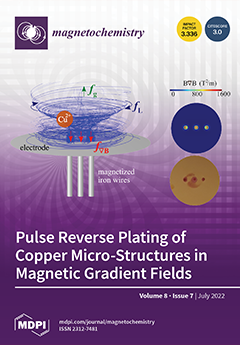A novel series of polypyridyl adducts, [Sm(ntfa)
3(NN)] (
2–
4), with ntfa = 4,4,4-trifluoro-1-(naphthalen-2-yl)-1,3-butanedionate, NN = 2,2′-bipyridine (bipy), 4,4′-dimethyl-2,2′-bipyridine (4,4′-Me
2bipy), and 5,5′-dimethyl-2,2′-bipyridine (5,5′-Me
2bipy) were synthesized from the precursor complex [Sm(ntfa)
3(MeOH)
2] (
[...] Read more.
A novel series of polypyridyl adducts, [Sm(ntfa)
3(NN)] (
2–
4), with ntfa = 4,4,4-trifluoro-1-(naphthalen-2-yl)-1,3-butanedionate, NN = 2,2′-bipyridine (bipy), 4,4′-dimethyl-2,2′-bipyridine (4,4′-Me
2bipy), and 5,5′-dimethyl-2,2′-bipyridine (5,5′-Me
2bipy) were synthesized from the precursor complex [Sm(ntfa)
3(MeOH)
2] (
1) and the corresponding pyridyl ligands. Single X-ray crystallography showed that the complexes displayed 8-coordinated geometry. The solid pyridyl adducts
2–
4 exhibited emission of luminescence in the NIR and visible regions with close quantum yields (QY = 0.20–0.25%). The magnetic data of
1–
4 showed larger values than those expected for magnetically noncoupled Sm(III) complexes in the
6H
5/2 ground state, with no saturation on the applied high magnetic field static at a temperature of 2 K.
Full article





